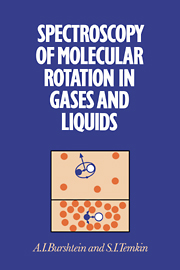Book contents
- Frontmatter
- Contents
- 0 Introduction
- 1 Rotational relaxation
- 2 Orientational relaxation in dense media
- 3 Transformation of isotropic scattering spectra
- 4 Quantum theory of spectral collapse
- 5 Rotational relaxation: kinetic and spectral manifestations
- 6 Impact theory of orientational relaxation
- 7 Rotation and libration in a fluctuating cell
- Appendix 1
- Appendix 2
- Appendix 3
- Appendix 4
- Appendix 5
- Appendix 6
- Appendix 7
- Appendix 8
- Appendix 9
- References
- Index
4 - Quantum theory of spectral collapse
Published online by Cambridge University Press: 06 November 2009
- Frontmatter
- Contents
- 0 Introduction
- 1 Rotational relaxation
- 2 Orientational relaxation in dense media
- 3 Transformation of isotropic scattering spectra
- 4 Quantum theory of spectral collapse
- 5 Rotational relaxation: kinetic and spectral manifestations
- 6 Impact theory of orientational relaxation
- 7 Rotation and libration in a fluctuating cell
- Appendix 1
- Appendix 2
- Appendix 3
- Appendix 4
- Appendix 5
- Appendix 6
- Appendix 7
- Appendix 8
- Appendix 9
- References
- Index
Summary
The quasi-classical theory of spectral shape is justified for sufficiently high pressures, when the rotational structure is not resolved. For isotropic Raman spectra the corresponding criterion is given by inequality (3.2). At lower pressures the well-resolved rotational components are related to the quantum number j of quantized angular momentum. At very low pressure each of the components may be considered separately and its broadening is qualitatively the same as of any other isolated line in molecular or atomic spectroscopy.
At the beginning, line shape theory concentrated on calculation of the width and shift of an isolated line broadened by collisions considered as instantaneous. This approach, known as ‘impact theory’, which originated with the pioneering work of Lorentz and Weisskopf, was initially purely adiabatic. The assumed adiabaticity of collisions excluded in principle any interference between spectral lines in the frame of impact theory. The situation changed with enhanced study of Stark multiplets of atoms in plasmas. The Stark sublevels were so weakly split in a weak electrical field of ions that a condition similar to (1.7) was met (ΔEτc ≪ 1) and a non-adiabatic generalization of impact theory became necessary. Transitions between Stark sublevels as an effective mechanism of their broadening were first taken into account by Kolb. Subsequently nonadiabatic theory was employed to describe overlapping Stark multiplets. It was mentioned that a qualitatively new feature arises when collisions are non-adiabatic: collisionally induced interference between components of the Stark structure causes spectral collapse.
- Type
- Chapter
- Information
- Spectroscopy of Molecular Rotation in Gases and Liquids , pp. 127 - 154Publisher: Cambridge University PressPrint publication year: 1994



